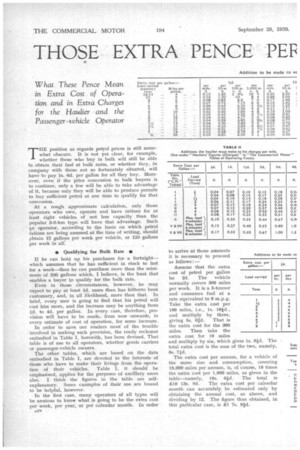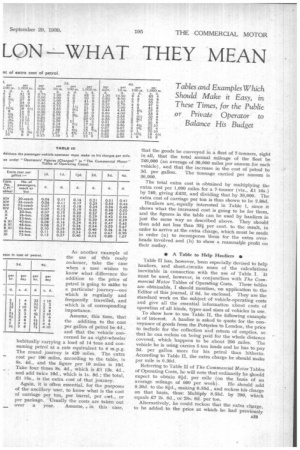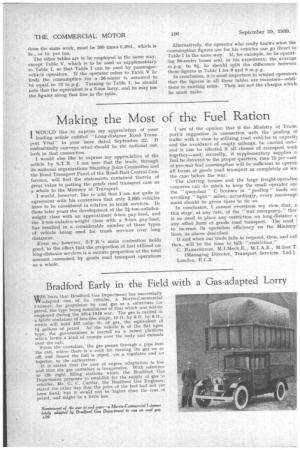THOSE EXTRA PENCE PEF -WHAT THEY MEAN
Page 26

Page 27

Page 28

If you've noticed an error in this article please click here to report it so we can fix it.
What These Pence Mean in Extra Cost of Operadon and in Extra Charges for the Haulier and the Passenger-vehicle Operator
Tables and Examples Which Should Make it Easy, in These Times, for the Public or Private Operator to Balance His Budget
THE position as regards petrol prices is still somewhat obscure. It is not yet clear, for example, whether those who buy in bulk will still be able to obtain their fuel at bulk rates, or whether they, in company with those not so fortunately situated, will have to pay is. 6d. per gallon for all they buy. Moreover, even if the price concession to bulk buyers is to continue, only a few will be able to take advantage of it, because only they will be able to produce permits to buy sufficient petrol at one time to qualify for that concession.
At a rough approximate calculation, only those operators who own, operate and have rations for at least eight vehicles of not less capacity than the popular 3-6-ton type will have that advantage. Such an operator, according to the basis on which petrol rations are being assessed at the time of writing, should .ohtain 15 gallons per week per vehicle, or 120 gallons per week in all
• Qualifying for Bulk Rate •
If he can hold up his purchases for a fortnightwhich assumes that he has sufficient in stock to last for a week-then he can purchase more than the mini mum of 200 gallons which, I believe, is the least that enables a buyer to qualify for the bulk rate.
Even in those circumstances, however, he may expect to pay at least id. more than has hitherto been customary, and, in all likelihood, more than that. In brief, every user is going to find that his petrol will cost him more, and the increase may be anything from id. to 4d. per gallon. In every case, therefore, provision will have to be made, from now onwards, in every estimate of cost of operation, for some increase.
In order to save our readers most of the trouble . involved in making such provision, the ready reckoner embodiecrin Table!, herewith, has been devised. That table is of use to all operators, whether goods carriers or passenger-vehicle owners.
The other tables, which are based on the data embodied in Table I, are devoted to the interests of those who have to make their livings from the operation of their vehicles. Table I, it should be emphasized, applies for the purposes of ancillary users also. I think the figures in the table are selfexplanatory. Some examples of their use are bound to be helpful, however.
In the first case, many operators of all types will be anxious to know what is going to be the extra cost per week, per year, or per calendar month. In order A2e to arrive at those amounts it is necessary to proceed as follows : Assume that the extra cost of petrol per gallon be 2d. The vehicle normally covers 360 miles per week. It is a 5-tonner and consumes fuel at a rate equivalent to 9 m.p.g. Take the extra cost per 100 miles, i.e., Is. 101(1., and multiply by three,
giving 5s. eid. That is the extra cost for the 300
miles. Then take the extra cost for 10 miles
and multiply by six, which gives Is. old. The total extra cost is the sum of the two, namely, 6s. 'ad.
The extra cost per annum, for a vehicle of the same size and consumption, covering 18,000 miles per annum, is, of course, 18 times the extra cost per 1,000 miles, as given in the
table-namely, 18s. &id. The total is
£16 13s. 9d. The extra cost per calendar month can accurately be estimated only by obtaining the annual cost, as above, and dividing by 12. The figure thus obtained, in this particular case, is £1 7s. 9fcl. As another example of the use of this ready reckoner, take the case when a user wishes to know what difference the addition to the price of petrol is going to make to a particular journey-one which is regularly and frequently travelled, and which is of corresponding importance.
Assume, this time, that the addition to the cost per gallon of petrol be 4d., and that the vehicle concerned be an eight-wheeler habitually carrying a load of 14 tons and consuming petrol at a rate equivalent to 4 mpg. The round journey is 420 miles. The extra cost per 100 miles, according to the table, is 8s. 4d., and the figure per 10 miles is 10d. Take four times 8s. 4d., which is gl 13s. 4d., and add twice 10d., which is is. 8d.; the total, 15s., is the extra cost of that journey.
Again, it is often essential, for the purposes of the ancillary user, to know what is the cost of carriage per ton, per barrel, per cwt., or per package. Usually the costs are taken out over a year. Assume, , in this case,
22 43 2 10 24 5
34
28 51 38 34 63 46 38 73 4 10
that the goods be conveyed in a fleet of 7-tonners, eight in all, that the total annual mileage of the fleet be 240,000 (an average of 30,000 miles per annum for each vehicle), and that the increase in the cost of petrol be 3d. per gallon. The tonnage carried per annum is 36,000.
The total extra cost is obtained by multiplying the extra cost per 1,000 miles for a 7-tonner (viz., Li 16s.) by 240, giving £432, and dividing that by 36,000. The extra cost of carriage per ton is thus shown to be 2.88d.
Hauliers are, equally interested in Table 1, since it shows what the increased cost is going to be for them, and the figures in the table can be used by hauliers in just the same way as described above. They should then add not less than 33i per cent, to the result, in order to arrive at the extra charge, which must be made in order (a) to recompense them for the extra overheads involved and (b) to show a reasonable profit on their outlay.
* A Table to Help Hauliers ID
Table II has, however, been especially devised to help hauliers, and short-circuits some of the calculations inevitable in connection with the use of Table I. It must be used, however, in conjunction with The Commercial Motor Tables of Operating Costs. These tables are obtainable, I should mention, on application to the Editor of this journal, if gd. be enclosed. They are the standard work on the subject of vehicle-operating costs and give all the essential information about costs of operation of all kinds, types and sizes of vehicles in use.
To show how to use Table II, the following example is of interest, A haulier is asked to quote for the conveyance of goods from the Potteries to London, the price to include for the collection and return of empties, so that he can reckon on being paid for the whole distance covered, which happens to be about 200 miles. The vehicle he is using carries 5-ton loads and he has to pay 2d. per gallon more for his petrol than hitherto. According to Table II, the extra charge he should make per mile is 0.30d.
Referring to Table II of The Commercial Motor Tables of Operating Costs, he will note that ordinarily he lhould expect to obtain 8icl. per Mile (on the basis of an average mileage of 600 per week). He should add 0,30d. to the 80., making 8.55d., and reckon his charge on that basis, thus: Multiply 8.55d. by 200, which equals £7 2s. (id., or 28s. 6d. per ton.
Alternatively, he could reckon that the extra charge, to be added to the price at which he had previously A25 done the same work, must be 200 times 0.30d., which is 5s., or Is. per ton.
The other tables are to be employed in the same way, except Table V. which is to be used as supplementary to Table I, so that Table I can be used by passengervehicle operators. If the operator refers to Table V he finds the consumption for a 26-seater is assumed to be equal to 12 m.p.g. Turning to Table I, he should note that the equivalent is a 2-ton lorry, and he may use the figures along that line in the table.
Alternatively, the operator who really knows what thE consumption figures are for his vehicles can go direct tc Table-I in the same way. If, for example, he be operating 36-seater buses and, in his experience, the averam m.p.g. be 8, he should split the difference betweer those figures in Table I for 8 and 9 m.p.g.
In conclusion, it is most important to remind operaton that the figures in all these tables are increases—addi• tions to existing rates. They are not the -charges whicl: he must make.




















































